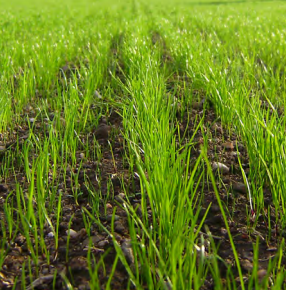Yes, we’re barely into Fall and already are talking about Spring. This is because a little lawn care effort now can go a long way once the snow has melted and the temperatures start to rise. Once November hits, the last thing we’re thinking about is lawn care – irrigation systems have been drained and winterized, mowers and trimmers have been stashed in the garage and the late season fertilizer has been spread. However, there’s still once task left to be undertaken: dormant seeding. If it’s been a rough summer and fall, dormant seeding will repair bare spots and thicken your grass (which helps to choke out pesky weeds) come the Spring.

The Process of Dormant Seeding
Dormant Seeding involves waiting to spread seed just before the ground freezes, but the ground and air temperatures are such that the seed won’t germinate until the Spring thaw. Timing is everything when it comes to dormant seeding, however, since if it’s too warm and the seed germinates, it’s unlikely the seedlings will be hearty enough to survive the winter and all your work will have been for naught. Also in order for dormant seeding to be successful, the seed needs to be able to make contact with the soil, so a thinner lawn is more ideal than a lush one.
Preparing The Lawn
As previously stated, a good soil to seed contact is necessary for dormant seeding to work, so it’s important to properly prepare the soil. The top centimetre of soil (approximately) should be loose, but this needs to go beyond just adding some topsoil.
If your lawn is patchy, or relatively thin, you may be able to use a rake to loosen the soil (using a small hand rake may be necessary if your soil is more compact). This will also help to remove any thatch that could suffocate your lawn over the winter. If large portions of your yard (or your entire lawn) needs seed, renting a power rake may be a good idea, as you can adjust the level of the blades to dig up the top ¼” of your yard. Just be sure not to use a rototiller – you don’t need to dig up your lawn, just scratch the surface. If you have a lot of thatch debris, or dead plant matter, rake it up gently so it doesn’t get in the way of the seed reaching the soil.
Seed Away
Follow the directions on your bag of seed and sow as you would normally, ensuring the seed is lightly incorporated into the soil. You will want to want to water enough to dampen the soil, but not to make it fully saturated, like you would in warmer temperatures. The cooler temperatures will keep the soil moist with less water.
Spring Expectations
Even with proper preparation, some spring overseeding may be necessary, especially if it is an atypical winter, where a good snowfall doesn’t last the winter to protect the dormant seed. But, don’t be disheartened. Remember, the grass will still have to sprout once the soil warms, so give it time.



